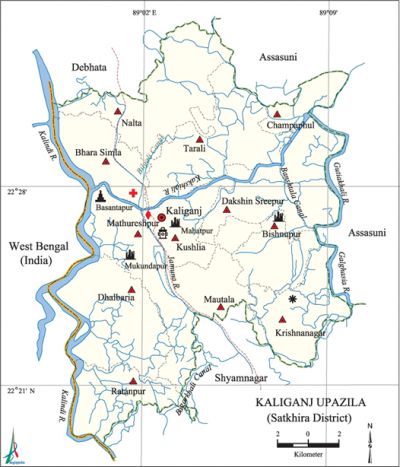Kaliganj Upazila (Satkhira District)
Kaliganj Upazila (satkhira district) area 333.78 sq km, located in between 22°19' and 22°33' north latitudes and in between 88°58' and 89°10' east longitudes. It is bounded by debhata and assasuni upazilas on the north, shyamnagar upazila on the south, Assasuni upazila on the east, west bengal state of India on the west.
Population Total 274889; male 136089, female 138800; Muslim 231610, Hindu 43027, Christian 242, Buddhist 1 and others 9.
Water bodies Main rivers: jamuna, Kakshiali, Galghasia, Kalindi, Gutiakhali; Bilgali, Banshtala and Bagarkhali canals are notable.
Administration Kaliganj Thana was formed in 1942 and it was turned into an upazila in 1983.
| Upazila | ||||||||
| Municipality | Union | Mouza | Village | Population | Density (per sq km) | Literacy rate (%) | ||
| Urban | Rural | Urban | Rural | |||||
| - | 12 | 243 | 254 | 16863 | 258026 | 824 | 59.93 | 51.2 |
| Upazila Town | ||||||||
|
Area |
Mouza |
Population |
Density |
Literacy rate (%) | ||||
| 7.15 | 6 | 16863 | 2358.46 | 59.9 | ||||
| Union | ||||
| Name of union and GO code | Area (acre) | Population | Literacy rate (%) | |
| Male | Female | |||
| Kushlia 55 | 5152 | 11537 | 11418 | 60.5 |
| Krishnanagar 47 | 5845 | 12148 | 13280 | 52.8 |
| Champaphul 23 | 7475 | 8318 | 8150 | 49.4 |
| Tarali 94 | 7338 | 11096 | 11022 | 50.2 |
| Dakshin Sreepur 31 | 4601 | 8611 | 9050 | 50.9 |
| Dhalbaria 39 | 8432 | 9751 | 10089 | 49.5 |
| Nalta 79 | 10117 | 17433 | 17286 | 53.9 |
| Bishnupur 15 | 4335 | 10927 | 11000 | 49.3 |
| Mathureshpur 63 | 7473 | 12962 | 13390 | 53.7 |
| Mautala 71 | 3163 | 9313 | 9586 | 47.6 |
| Ratanpur 87 | 7512 | 11681 | 12220 | 51.5 |
| Bhara Simla 13 | 5777 | 12312 | 12309 | 48.8 |
Source Bangladesh Population Census 2011, Bangladesh Bureau of Statistics.
Archaeological heritage and relics Prabajpur Jami Mosque (Dhalbaria), Dargah of Madina Pir (Kushlia), tomb of Ganjon Pir (Ratanpur), tomb of Kangali Pir (Bhara Simla), tomb of Pir Ahsanullah (Nalta), Radha Govinda Jeu Mandir (Ratanpur), Nabaratna Mandir (Dhalbaria), Kali Mandir, Fort of Bikramaditya (Mathureshpur), Garh of Pratapaditya (Mahatpur), Damdama (fort).

War of Liberation During the war of liberation in 1971 Kaliganj was under Sector 9. There had been a number of encounters between the freedom fighters and the Pak army during this time in the upazila the most notable of which are at Basantapur, Khanzia, Pirojpur, Nazimganj, Dudli and Ukshar. Kaliganj was liberated on 20 November 1971.
For details: see কালীগঞ্জ উপজেলা (সাতক্ষীরা জেলা), বাংলাদেশ মুক্তিযুদ্ধ জ্ঞানকোষ (Encyclopedia of Bangladesh War of Liberation), বাংলাদেশ এশিয়াটিক সোসাইটি, ঢাকা ২০২০, খণ্ড ২।
Religious institutions Mosque 347, temple 19, tomb 5. Noted religious institutions: tomb of Choto Miah, tomb of Buro Pir, Three Temple, Kali Mandir.
Literacy rate and educational institutions Average literacy 51.7%; male 55.4%, female 48.2%. Noted educational institutions: Kaliganj Degree College (1969), Dakshin Shreepur Kushlia Higher Secondary School (1926), Bishnupur Prankrishna Memorial School (1930), Dhuliapur High School (1930), Kaliganj Pilot High School (1936), Nalta High School, Champaphul Secondary School (1924), Nengi Secondary School (1929).
Newspapers and periodicals Periodicals: Gram Bangla (1987), Kakshiali (1992), Surya Tarun, Fariad, Kaliganj Barta, Nadi (1993), Mukti Surya (1995), Arjita Kantha (1998), Mukto Alap (2002), Raktim Surya (2004),' Al-Ahsan (2005), Smriti (2005), Bragratat (2005).
Cultural organisations Government Public Library, Ahsania Public Library (1980), Shaheed Smriti' Library (1995), brac Uttar Kaliganj Public Library (2001), BRAC Karbala Public Library (2003), Sushilan Library (2002), Sumon Literary Group (1980), Kaliganj Literary Academy (1993), Kaliganj Theatre Group (1995), Fatehpur Cultural Organisation (1981).
Main sources of income Agriculture 56.81%, non-agricultural labourer 6.05%, industry 2.71%, commerce 19.88%, transport and communication 2.40%, service 4.37%, construction 0.93%, religious service 0.20%, rent and remittance 0.30% and others 6.35%.
Ownership of agricultural land Landowner 52.48%, landless 47.52%; agricultural landowner: urban 43.45% and rural 53.03%.
Main crops Paddy, potato, brinjal, betel leaf, sweet potato, vegetables.
Extinct or nearly extinct crops Linseed, sesame, 'mug, khesari, arahar.
Main fruits Mango, jackfruit, litchi, water-melon, futi, 'banana, papaya.
Fisheries, dairies and poultries This upazila has a number of fisheries and poultries.
Communication facilities Pucca road 206.5 km, semi-pucca road 92 km, mud road 649.5 km.
Extinct or nearly extinct traditional transport Palanquin, horse carriage.
Noted manufactories Flour mill, ice factory, fish processing factory, oil mill, rice mill, printing press.
Cottage industries Goldsmith, potteries, weaving, bamboo work, nakshi kantha, jute work, wood work.
Hats, bazars and fairs Hats and bazars are 50, fairs 2, most noted of which are Nalta Hat, Nazimganj Hat, Kaliganj Hat, Banshtala Hat, Bishnupur Bazar, Ratanpur Bazar, Krishnanagar Bazar, Rathjatra Mela (Kushlia), Nalta Shorifer Mela are notable.
Main exports Betel leaf, shrimp.
Access to electricity All the unions of the upazila are under rural electrification net-work. However 32.2% of the dwelling households have access to electricity.
Sources of drinking water Tube-well 77.8%, tap 14.6% and others 7.6%. The level of arsenic in the shallow tube-well water of the upazila is very acute.
Sanitation 42.91% of dwelling households of the upazila use sanitary latrines and 48.36% of dwelling households use non-sanitary latrines; 8.73% of households do not have latrine facilities.
Health centres Upazila health complex 1, family planning centre 8, clinic 5, union health centre 3.
Natural disasters Many people were victims of the cyclones of 1970 and 1988; these also caused heavy damages to settlements, livestock and crops of the upazila.'
NGO activities Operationally important NGOs are brac, asa, Sushilan. [Sachhida Nanda De]
References Bangladesh Population Census 2001 and 2011, Bangladesh Bureau of Statistics; Field report of Kaliganj Upazila 2007.
